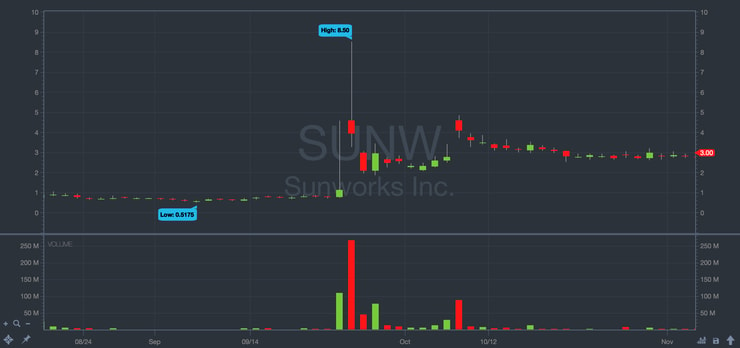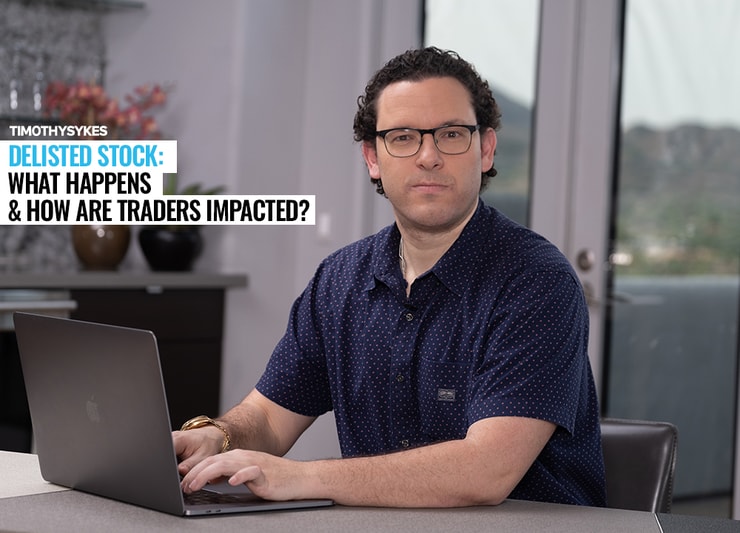I get this one a lot — what is a delisted stock, and why should traders care?
Getting listed on a big board isn’t easy. A company needs to meet some tough listing requirements. When it gets disqualified, it can badly shake investor confidence.
That seems like bad news right? But for traders, delistings can mean both risk and opportunity.
Exchanges suspended delistings during the COVID-19 stock market slide. But now, it’s back to business as usual.
You’re probably here because you’re curious about the penny stocks I’ve traded on my way to $6 million in profits.*
(*These results are not typical. Individual results will vary. Most traders lose money. My top students and I have the benefit of many years of hard work and dedication. Trading is inherently risky. Always do your due diligence and never risk more than you can afford to lose.)
Hopefully, you’ve read my penny stock guide, where I explain what I like about these stocks.
A lot of these penny stocks trade on the OTC markets, where most stocks delisted in the U.S. also end up. So read on for some extra credit.
Table of Contents
- 1 What Is a Delisted Stock?
- 2 Why Does a Stock Get Delisted?
- 3 Voluntary Delisting vs. Involuntary Delisting
- 4 What Happens if a Stock Is Delisted?
- 5 Are Delisted Stocks Worthless?
- 6 Can Companies Benefit from Delisting Their Stocks?
- 7 How Are Traders Impacted by a Stock Delisting?
- 8 List of Delisted Stocks in 2020
- 9 How to Sell a Delisted Stock
- 10 Can Delisted Stocks Come Back?
- 11 Conclusion
What Is a Delisted Stock?
When it’s removed from a regulated exchange, a stock is delisted … usually meaning that it’s being sold on the anything-goes OTC markets.
Stocks with a minimum share price of $4 can list on the NYSE. It’s $3 for Nasdaq. There’s also a raft of other requirements. These include the number of shareholders and publicly floated stock.
These factors are intended to enforce a certain amount of liquidity.
If a share price falls below $1, the exchange issues a stock suspension notice.
A stock delisted no longer has to follow Nasdaq or NYSE listing requirements. And it doesn’t need to follow SEC accounting rules.
Penny stocks that have fallen below $1 make up half of delistings. But a company may voluntarily or involuntarily move its stock to the OTC boards. Here’s a closer look…
Why Does a Stock Get Delisted?
Stocks can rise or fall dramatically after a delisting.
Not all stock delistings are bad for trading. But you need to understand why exchanges and companies delist stocks.
Let’s get specific on this.
Voluntary Delisting vs. Involuntary Delisting
There are two routes delisted stocks can take. Both can happen for legitimate reasons. But it’s anyone’s guess how the market will respond.
The following may all come into play…
It Doesn’t Meet Listing Requirements
An exchange or regulators can delist a stock — as can the company itself. The most common reason for an exchange delisting is if the stock falls below $1 per share. Another is if it falls below an exchange’s market cap limit.
The Nasdaq and NYSE have similar stock delisting rules. When the stock trades below $1 for 30 consecutive days, it will be notified. The company must bring its share prices up within a specified time window.
The company must meet a closing price of $1 or more for 10 consecutive days. After six months of the stock trading below $1, the exchange might delist it.
In September, Nasdaq got tougher on delistings for low-priced stocks. The exchange can delist a stock in only 10 days. How? If the stock price trades below 10 cents for 10 consecutive days — boom! Nasdaq can issue a stock suspension.
Reverse Stock Splits
Penny stocks often do reverse stock splits to boost share prices and avoid a delisting. But if the cumulative ratio reaches 250 shares or more to one, the exchange will delist the stock.
Reverse stock splits often trade around the pre-split price. But if they pop, you don’t want to miss it.
One example is Taoping (NASDAQ-CM: TAOP). TAOP had a 1-to-6 reverse stock split in July.
The reverse split followed a delisting notice. Currently, the stock is trading below $3, up a tad from its pre-split price.
The stock jumped to $8.80 the day of the split, July 30. If you blinked, you likely missed this trade.
That’s why you’ve gotta use the right tools. I helped design the StocksToTrade platform for the low-priced stocks I like to trade. It covers all the bases in searching for stock picks. Price alerts, charting, indicators, news feeds — that’s just a short list.
More Breaking News
- Eye-Catching Developments
- Is CoreWeave’s Rise a Fading Spark?
- BlackBerry’s Unexpected Surge: What’s Fueling It?
Bankruptcy
When a company files for Chapter 11 bankruptcy, the stock’s value usually tumbles. A U.S.-listed stock can still trade, but not on the big boards.
The stock will trade in the OTC pink sheet market. The letter Q at the end of the ticker notes a company is in bankruptcy.
Ceases Operations
When a company decides to close down, it delists its stock.
Does that mean investors are then stuck with a worthless stock? Selling the stock of a defunct company is like trying to sell a recalled car. If the stock is still traded, you can try to find a buyer…
But be aware your broker may no longer support the stock or quote a price.
Rental car company Hertz has reinvented how to sell delisted stock on Robinhood. Over 100,000 Robinhood investors bought the initial bankruptcy offering (IBO).
This is why you need to do your research. Hertz is using the capital raised to pay its creditors. It could be worthless after that.
Mergers and Acquisitions
What happens to a stock when the company is acquired?
Here’s an example:
Financial giant Morgan Stanley acquired E-Trade. And in October, E-Trade voluntarily delisted.
About a quarter of Nasdaq’s delistings since August are acquisitions and mergers. Big companies are scooping up promising companies while prices are low.
What does this mean for traders? The target stock’s price will rise. Acquirers offer a higher share value to encourage shareholders to agree to the deal. But not all deals will go through.
Foreign Stock Restrictions
Chinese companies are voluntarily delisting from US exchanges. Where are they going? To the Hong Kong stock exchange (HKEX).
U.S. regulations are becoming too strict for many Chinese stocks. And they’re about to get stricter. In 2022, auditors will need to certify that U.S.-listed Chinese companies are not under government control.
What Happens if a Stock Is Delisted?
First, the exchange issues a delisting warning. The company has a grace period to get into compliance. If it doesn’t, the exchange will issue a trading suspension. Delisting notices and suspensions are useful screens to add to your watchlist.
A stock could bounce by appealing the suspension. Then it can either comply or fall off the big boards. Either way, the stock price will move.
Advantages of Delisting
Companies sell shares to raise capital. That’s also why they put up with the hassle of listing on one of the big exchanges. The requirements help reassure investors that the stock isn’t sketchy.
Companies can get delisted for both sketchy and non-sketchy reasons. These reasons can make investors squeamish. But as a trader, you shouldn’t mind sketchy stocks. Sketchy stocks can make for some awesome volatility.
For traders like me, that’s the main benefit of delisting from the regulated stock exchanges. I trade volatility. It’s how I’ve made over $6 million in trading profits in my career.*
Not used to trading volatile stocks? Watch my no-cost, two-hour “Volatility Survival Guide” and learn how. I made it to help traders just like you in the crazy pandemic market and beyond.
Disadvantages of Delisting
While it can be fun to ride the stormy seas, there are disadvantages. Occasionally, you crash.
In the stock market, this can mean getting locked into your position. When trading volume plummets, it can be hard to get out of a position at the price you want. When that insolvency is combined with a delisted stock’s volatility, the result can hurt.
Are Delisted Stocks Worthless?
Once delisted, most stock prices decline.
A bankrupt stock is more likely to become worthless. But stocks like J.C. Penney (OTCPK: JCPNQ) and Frontier Communications (OTCPK: FTRCQ) could survive in some form. Another company could buy them for their assets if they pay down their huge debts.
A bankrupt company could still find ways to boost its delisted stock price. Watch for these catalysts:
- Share buybacks: The company buys back its own shares to boost the share price.
- Insider buys: J.C. Penney’s chairman bought back one million shares in August to stave off a delisting. The purchase caused the stock to spike.
- Reverse stock splits
- Mergers or acquisitions
Can Companies Benefit from Delisting Their Stocks?
Company motives aren’t always in line with those of traders. When delisting is voluntary, you can bet that the company knows what it’s doing.
They can be looking for less regulation. Or maybe it’s a way to depress their share price ahead of a buyback.
These things aren’t always good for investors. But they can lead to the volatility that traders thrive on.
How Are Traders Impacted by a Stock Delisting?
Should you stay off of sinking ships? Or buy more shares on the dip?
Let’s look at an example.
Sunworks (NASDAQ-CM: SUNW) received delisting notices in May and September. The stock is on a wild ride. The price ranged from under $1 to $8.50 the week of the last notice.
In September, I went long on an intraday breakout for a $3,546 win.* This was a small gain in a week of breakouts.
Sunworks says it’s working on meeting listing requirements, so a dip buy opportunity is worth a look.

List of Delisted Stocks in 2020

2025 Millionaire Media, LLCBoth the NYSE and Nasdaq update their delisted stock lists daily.
The NYSE has its ‘Noncompliant Issuers’ list. The Nasdaq has an ‘Issues Pending Suspension or Delisting’ list.
How to Sell a Delisted Stock
When an exchange boots a stock, investors might flee. If you’re holding and hoping when that time comes, you’ve already ignored rule #1 to cut losses quickly. And probably more than that…
Can Delisted Stocks Come Back?
Like most other penny stocks, most delisted stocks will fail. Some delisted companies could make a big comeback.
Sometimes they can do both.
Iridium World Communications (OTC: IRIDQ) is a satellite communications company. It delisted from Nasdaq in 1999. The U.S. government pumped $72 million into the bankrupt company a few months later.
Today, the defense contractor generates half a billion dollars in sales. It just blasted 66 new satellites into space on SpaceX rockets.
Its old shares currently trade under the dreaded caveat emptor designation … for less than 1 cent.
But it regained a Nasdaq listing through a reverse merger. It now trades as IRDM, with a market cap of $3.7 billion.
Conclusion
Delisted stocks can be sketchy … and still present many trading opportunities. Welcome to the world of penny stocks. Sometimes trading is counterintuitive.
You’ve got to do your research to really know. And some help never hurts.
StocksToTrade released its Breaking News Chat feature this year. It’s changed my trading. Especially in such a crazy year for the markets.
The crew helped me enter this dip trade at the right point. I pocketed $12,000 in an hour.*
Trading isn’t easy. So invest in your knowledge account first. That’s what I teach in my Trading Challenge. And it’s why I share all these great free resources, like my YouTube video lessons. I want you to succeed. So I share my over two decades of trading experience to help you shorten your learning curve.
Please, read my penny stock guide. Apply to my Challenge if you’re really serious.
Whatever you do, don’t say I didn’t warn you.
Do you trade delisted stocks? What’s your strategy? Comment below, I love to hear from all my readers!








Leave a reply